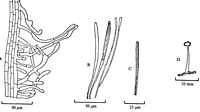|
 Chlorovibrissea tasmanica Chlorovibrissea tasmanica
SynonymsVibrissea tasmanica
BiostatusPresent in region - Indigenous. Non endemic
Images (click to enlarge)
Caption: Fig. 1. Vibrissea tasmanica. (A) Cortex of stalk with hairs. (B) Ascus and paraphyses. (C)
Fascicle of ascospores. (D) Sketch of ascoma in section. |
Article: Beaton, G.W.; Weste, G. (1983). A new species of Vibrissea from North Island, New Zealand. New Zealand Journal of Botany 21(3): 281-283 (http://www.rsnz.org/publish/abstracts.php).
Description: Ascomata superficial, solitary or several arising from a common mycelial pad, stipitate, up
to 14 mm high, fertile head subglobose or lobed, to 3 mm diam, pale green when fresh
(Rodway) be coming pale brown on dried specimens, totally covered with the hymenium
except where the stem is inserted in an umbilicus, stalk 1 mm thick at the base, tapering
upward, pale green fading to pale brown at the apex. Medullary excipulum a narrow band
of interwoven, hyaline hyphae up to 3 mm diam. in a gelatinous matrix and merging into
the parallel hyphae of the stem which is composed of two distinct tissues - the cortical layer
up to 100 µm thick of parallel pigmented hyphae with cells up to 40 x 10 µm, the inner
tissues of long-celled very thin walled hyaline or lightly pigmented hyphae with finely
granular contents up to 5 µm diam. The stem is covered with a dense layer of superficial,
septate hairs, simple or branched cylindrical or with inflated and contorted cells, up to 150 x
9 µm. Asci cylindrical with a long slightly tapering stalk, with 8 spores in a fascicle, the
small pore blued with iodine, 105-120 x 4-5 µm. Ascospores filiform, slightly tapering,
septate, 1-1.5 µm diam, fascicles not exceeding 70 µm in length. Single ascospores not
measured. Paraphyses cylindrical with clavate tips, 1-5 µm thick, tips to 3 µm thick, 15
µm longer than asci, simple or branched from lower third.
Notes: This species occurs on fragments of eucalyptus debris immersed in water or lying on very
wet ground and is apparently rare in Tasmania and not yet recorded in Victoria.
Article: Rodway, L. (1925) [1924]. Two interesting fungi. Papers and Proceedings of the Royal Society of Tasmania 1924: 8.
Description: Vibrissea. tasmanica, - n.s. Solitary or two or more arising from a common base, on dead
twigs in the water or on wet ground; stem slender, glabrous, pale dull green, up to 1 cm. long;
head hemispheric, 3-4 mm. diameter, umbilicate beneath for the insertion of the stem, pale
dull green glabrous, asci narrow, cylindric, 180 x 3 µ, spores filiform 80-120 x 1 µ, about 10
septate.
|